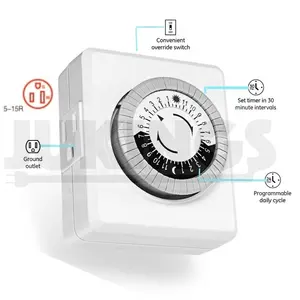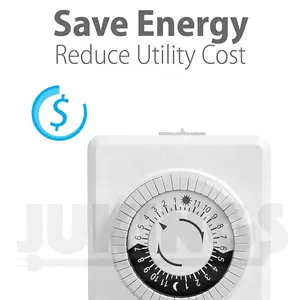
All categories
Featured selections
Trade Assurance
Buyer Central
Help Center
Get the app
Become a supplier

(2095 products available)





































Various kinds of 24-hour countdown timer can be found on the market, each with unique features and advantages to suit different needs. Digital timers, mechanical timers, and programmable timers are among these variations. Each kind has its advantages, and the choice depends on the required features, ease of use, and specific applications.
Digital countdown timer
Digital countdown timers are easy to read and understand due to their clear digital display. They usually have features such as multiple timers, alarm signals, and memory settings for previous countdowns. These timers can be used for various purposes, including cooking, exercising, and managing time in classrooms or workplaces.
Mechanical countdown timer
Mechanical countdown timers are reliable and durable because they are powered by mechanical clockwork instead of batteries or electricity. These timers often have a traditional design with analog displays, such as turning a knob to set the desired countdown duration. They are suitable for applications where electronic devices may not be allowed or where users prefer a simple and straightforward device.
Programmable countdown timer
As the name suggests, the programmable countdown timer allows users to program specific countdown durations and corresponding alarms or signals. These timers are often equipped with a user-friendly interface, such as touchscreens or buttons, to set and modify the countdown parameters easily. They can also have advanced features such as preset programs, repetitive countdowns, and remote control capabilities.
Several design aspects make a timer useful, practical, and easy to use.
Form factor
Timers come in different form factors to fit various applications. Portable timers are small, light, and often include clips or stands for easy attachment to equipment or placement on work surfaces. They are powered by batteries or USB connections. Wall-mounted timers are larger and designed to be fixed onto walls or other surfaces. They usually require a power source and are suitable for applications where a timer needs to be visible to many people from a distance. Rack-mounted timers are designed to fit into standard 19-inch equipment racks. They are used in data centers, control rooms, and other environments where equipment racks are standard.
Display
Countdown timer displays must be clear and easy to read. LED displays are bright and can be seen from a distance, making them suitable for both portable and wall-mounted timers. LCD displays are commonly used for smaller, portable timers, providing good detail for shorter time intervals. Some advanced timers use touchscreen interfaces, allowing users to set the timer, start, stop, and reset it with simple taps. Touchscreens can display complex information in a user-friendly manner.
Buttons and controls
Physical buttons are simple and effective for controlling a timer. Common buttons include start, stop, reset, and mode (for switching between countdown and count-up). Depending on the timer, rotary switches or dials can allow users to set the desired countdown time. The timer beeps, buzzes, or makes audible alerts when it reaches the end of the countdown. Many timers allow users to adjust the volume of these alerts or turn them off.
Power source
Portable timers are powered by batteries or USB connections. Wall-mounted and rack-mounted timers usually require a constant power source. Some modern timers can operate using solar energy, making them environmentally friendly and cost-effective in the long run.
Construction material
Plastic is lightweight, cost-effective, and suitable for most environments. Metal construction, such as aluminum or stainless steel, provides durability and a professional appearance. This is important for timers used in commercial or industrial settings. Silicone and rubber are used as protective casings for portable timers. They provide shock resistance, water resistance, and a non-slip surface, making the timer suitable for outdoor and workshop use.
Various industries and sectors find the 24-hour countdown timer to be a useful tool. These tools help with time management and increase productivity. They help in keeping track of time and improving efficiency in work. Their practicality and versatility make them indispensable. They are used in alarm clocks, cooking, sports, event management, health care, and many other fields. These are some important applications of the timer.
Industrial applications
In manufacturing, a timer is used to monitor machine operations. It also keeps track of production cycles. These processes ensure that the machines operate within the set time limits. They also help prevent wear and tear. In process control, the timer helps in regulating processes such as chemical reactions. It also regulates mixing and assembly lines.
Laboratory experiments
Scientific research and experiments often depend on precise timing. A timer helps to control variables. It also ensures the repetition of test conditions. In experiments with time-sensitive aspects, such as chemical reactions, the timer is essential for accuracy and reliability.
Cooking and food preparation
In commercial kitchens, the timer is used to manage cooking times for different dishes. The timer ensures that food is cooked properly. It also helps to maintain consistency in food quality. It aids in coordinating multiple tasks simultaneously. This coordination is important in fast-paced food service environments.
Transportation and logistics
In logistics, the timer is essential for managing schedules. It also helps to monitor delivery times. The timer is crucial in the countdown to departure or arrival in the transportation sector. It is especially important in aviation, shipping, and public transportation for ensuring punctuality and safety.
Event management
Event organizers use the timer to ensure everything runs smoothly and on schedule. They are used to count down to the start of an event. They are also used to manage speaker times and session transitions. They help in keeping the event on track.
Education and classrooms
Teachers can use timers to manage class time. They can also use them to allocate time for assignments and activities. The timer helps maintain a structured learning environment. It also promotes time management skills among students.
Health care
In hospitals, the timer is used to monitor medication schedules. It can also be used to time medical procedures. They are crucial for ensuring timely treatments. They also ensure adherence to protocols. In fitness training, the timer can be used to regulate exercise intervals. It can also be used to track workout durations. They are essential for optimizing training sessions.
When choosing a countdown timer for a 24-hour period, there are a number of things to consider to ensure it meets one's needs. These features and factors include:
Purpose and Application:
Identify what the timer will be used for. Is it for industrial applications, cooking, sports, or event management? Different applications may have specific features.
Display Type:
Choose between digital displays, LED displays, or mechanical clocks. Digital displays are easy to read, while LEDs can be seen from a distance, and mechanical clocks have a classic appeal.
Power Source:
Consider the power source. Will it be powered by batteries, electricity, or both? Battery-powered timers offer portability, while electric timers do not require frequent battery replacements.
Durability and Build Quality:
Look for a timer with solid construction, especially if it will be used in harsh environments. Features such as water resistance, shockproofing, and robust materials can enhance longevity.
Ease of Use:
Consider how easy it is to use the timer. It should have intuitive controls, clear instructions, and easy-to-read displays. Complicated timers may lead to errors and frustration.
Programmability and Customization:
See if the timer is programmable and customizable. It should allow users to set multiple countdown periods, recurring timers, and alarms. Some timers may even offer programmable presets for common tasks.
Additional Features:
Look for extra features that may enhance the timer's functionality. These include alarm functions, memory settings, remote control capabilities, and synchronization with other timers.
Size and Portability:
Consider the timer's size and portability. If it needs to be moved frequently, a compact and lightweight timer is better. For stationary use, size may be less critical.
Visibility:
The visibility of a timer is crucial, especially in loud environments or large spaces. Choose a timer with a bright, easily readable display. Some timers offer adjustable brightness and large font options for enhanced visibility.
Cost and Budget:
Set a budget and compare the costs of different countdown timers. Remember, a timer with high-quality features may offer better value in the long run.
Q1: How does a 24-hour countdown timer work?
A1: A 24-hour countdown timer sets a specific duration for an event, after which the timer signals the end of the period. The user sets the desired time, and the timer counts down the remaining time, usually displayed on a digital screen.
Q2: What are the applications of 24-hour countdown timers?
A2: These timers are useful in various settings, including schools, gyms, kitchens, industrial processes, and event management, where keeping track of time is essential.
Q3: What are the advantages of using a 24-hour countdown timer?
A3: They help manage time efficiently, enhance productivity, ensure timely completion of tasks, and add a competitive element to activities.
Q4: Are 24-hour countdown timers waterproof?
A4: Some models are waterproof or water-resistant, making them suitable for use in wet environments like kitchens or outdoor events.
Q5: Can a 24-hour countdown timer be reset once it reaches zero?
A5: Yes, most timers can be reset and set for a new countdown period. However, some may have a default setting that needs to be reset before reprogramming.